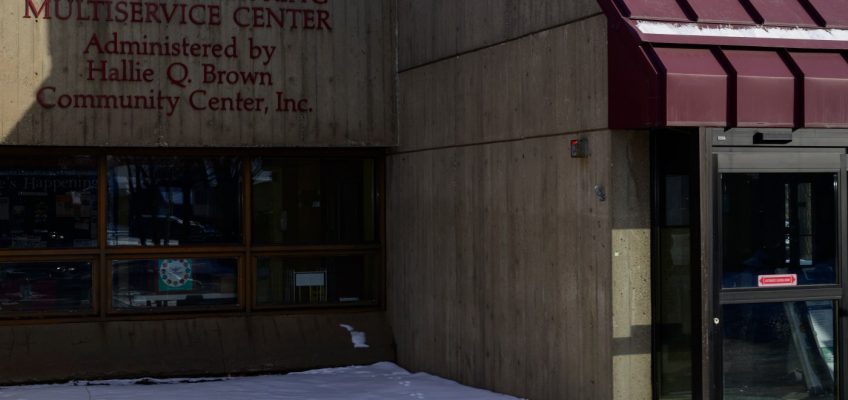New York’s infamous ‘Hole’ neighborhood in East New York is slated for resiliency upgrades, a rezoning, and more housing.
A stitched panoramic view looking south down 75th Street into “The Hole” from South Conduit Boulevard. (Adi Talwar/City Limits)
When you walk south down Ruby Street, from Conduit Boulevard to Linden Boulevard in the easternmost bit of Brooklyn, you descend 10 feet.
That 12-block depression that straddles the Brooklyn-Queens border has been infamously dubbed “The Hole” because it sits below the other land around it—and it’s not connected to the city’s sewer system.
Every time it rains, the streets flood. And so do the homes of the neighborhood residents.
“I get three feet of water in my basement,” said Jimmy, a north Jewel Streets resident who preferred to go only by his first name.
After decades of neglect, local community groups are optimistic about a city plan to transform the neighborhood.
The $146 million project will build sewers, add a chain of ponds for rainwater to flow to Jamaica Bay, and unlock the development of as many as 5,000 units of housing.
The proposal finally has momentum after community groups pushed the city’s Department of Environmental Protection, Housing Preservation and Development, and local councilmembers to take action.
“For far too long, this community has gone without basic infrastructure, fending for themselves in the face of constant flooding, faulty septic systems, and rampant illegal dumping. Today, we move towards a more livable, resilient future for the neighborhood,” said Meredith McNair, senior community planner with the Cypress Hills Local Development Corporation when the plan was announced.
Blake Avenue near 77th Street. (Adi Talwar/City Limits)
From ‘The Hole’ to the Jewel Streets
When you walk through The Hole, you hear the splash of tires splitting puddles of water, trucks rumbling by—even goats bleating.
But in between those moments of chaos, there’s peace.
“It’s like the country down here,” said Jimmy.
Goats in an empty lot on the South West corner of Ruby Street and Blake Avenue. (Adi Talwar/City Limits)
The streets, once asphalt, are a dusty mix of storm runoff and dirt on a good day. After a rain, the roads are completely inundated with floodwater.
For decades, it’s been a free-for-all in The Hole. Illegal industrial businesses operate on some of the vacant lots, sending loud trucks down streets that are intended just for residential use.
“Do you know how long I’ve been complaining about this? I don’t make any noise,” said Jimmy. He’s lived in the Jewel streets all his life, and said he’s seen the gamut of businesses and hustlers making use of the vacant lots.
“There was a bus company, yellow bus company, five o’clock in the morning, you would hear backup alarms,” he said. Another adjoining property, he says, “ended up becoming a parking lot for the airport. All hours of the night, there were people here beeping.”
Sean, a local resident, on Dumont Avenue near 77th Street. (Adi Talwar/City Limits)
For decades, the Department of Environmental Protection had funding for sewer construction in The Hole. But the city hadn’t been able to push the project forward.
In 2022, residents sent a letter to the Adams administration demanding change, kicking off two years of community engagement.
“We were pissed off. Angry. Just because we were left so many years unheard. We felt like the retaining wall at the dead end street, just trapped, like we didn’t exist,” said Julisa Rodriguez, who lives at the south end of Sapphire street with her children.
The East New York Community Land Trust and the Cypress Hills Development Corporation led the organizing effort, knocking on doors, convening residents, and negotiating with the city. They asserted their desire for a true neighborhood.
Homes along Sapphire Street, where Julisa Rodriguez lives with her children. (Adi Talwar/City Limits)
Hannah Anousheh, director of the East New York CLT, called it a “masterclass” in working with—but also pushing—the city.
“We have to give them credit… but at the same time they have to constantly be pushed and constantly be told they have to listen to residents,” said Anousheh.
Since then, things have improved modestly. The city added catch basins in the ground to absorb some of the flooding—but it still takes the streets a day or two to drain.
The city also started cracking down on businesses operating illegally on the streets that were causing disturbances.
After two years, the plan that emerged was not for The Hole but reimagined as the Jewel Streets—named after Sapphire, Amber, Emerald, and Ruby streets that run North to South through the neighborhood.
‘Blue belts’ and buyouts
To fix the Jewel Streets, planners are fighting nature itself.
“Our sewer system runs on gravity,” said Michael Sandler, assistant commissioner for neighborhood strategies at HPD.
The Hole follows the path of what was once Spring Creek—which has since been paved over. But water still yearns to run through the historic channel. When it can’t flow, it sits below sea level in The Hole.
76th Street near South Conduit Boulevard. (Adi Talwar/City Limits)
With more frequent, more severe storms from a changing climate, the flooding is getting worse.
Not being part of the sewer system also presents unique challenges, Sandler added. “When they flush their toilet, it just drains into the yard next to their house, and that dirt has standing water, so septic stuff flows back out into the neighborhood because of the grade.”
A plan to manage stormwater will create two ponds on the north side of Linden Boulevard that will collect rain. Then the water will flow under Linden, and get pumped up to Spring Creek, which empties into Jamaica Bay.
A plan to manage stormwater for the neighborhood. (Credit: Jewel Streets Neighborhood Plan, via the mayor’s office)
With water runoff managed in a “blue-belt” that will recreate and uncover the path of the historic Spring Creek, the city can then raise the below-grade streets, unlocking the potential for new development.
A “blue belt” will drain water away from the neighborhood
(Credit: Jewel Streets Neighborhood Plan, via the mayor’s office)
“Resiliency and quality of life investments for the residents of the Jewel Streets, will allow thousands of new homes, including a very significant amount of affordable housing,” said Sandler.
That will leave many of the neighborhood’s existing homes several feet below the new street—requiring adaptation lest they continue to be at significant flooding risk.
In the Jewel Streets, the city is testing its first ever pre-disaster buyout program. Usually, the government only offers buyouts after a disaster happens—like it did after Hurricane Sandy.
But knowing that the neighborhood will flood again, officials are seeking to be proactive, offering Jewel Streets homeowners the option of having the city purchase their land.
A new neighborhood
When all of that’s built—which could take years, planners say—the Jewel Streets will finally have the ingredients of a new neighborhood.
The city wants to rezone more than 20 blocks to facilitate the development of new housing, activate commercial strips, and bring more amenities to the community.
The area is a 15 minute walk from two subway stations at Grant Avenue on the North side of Conduit Boulevard and Euclid Avenue in East New York.
Without regular street crossings, residents carve their own path across Conduit Boulevard to get to the subway. (Adi Talwar/City Limits)
Planners also want to add passenger islands for the B55 bus route, and more pedestrian crossings on busy Linden Boulevard.
A 17 acre city site on the south side of the street will continue the blue belt, with more ponds connecting to Jamaica Bay. The rest of the land will support up to 1,400 new homes.
Facilitating that development will require navigating the city’s often-contested land use process, where residents will continue to weigh in, as well as local councilmembers.
The area straddles both Brooklyn and Queens, represented by Brooklyn Councilmember Chris Banks and Queens Councilmember Joann Ariola.
“I think the plan is a good plan as it is now,” said Banks, who is cautiously optimistic about the rezoning.
Ariola declined to comment on this story.
The rezoning process wouldn’t kick off until 2026, when Mayor-elect Zohran Mamdani will be in office. Mamdani did not respond to a request for comment on the proposal.
Looking north up 77th Street from Dumont Avenue. (Adi Talwar/City Limits)
“We just need to make sure that the next administration has continuity and a commitment to deliver those funds so that we can get this over the finish line,” said Banks.
After years of broken promises, residents of the Jewel Streets are allowing themselves to hope, just a little bit.
“We’re heading in the right direction. There’s still a lot of unknowns, still a lot of questions,” said Rodriguez.
Some organizers are calling to put some of the land into a community land trust that would be resident-controlled condominiums, with an option for existing residents to move into new, permanently affordable homes.
Rodriguez told City Limits that, if she gets a fair price, she plans to take the city’s buyout offer and look for another home—though she worries she may not be able to afford New York City prices.
She said the buyout would be the best thing for her family and her children.
“I envision the plan finally being implemented, although for me, I would prefer to relocate,” said Rodriguez.
“I can’t hide my sentiments of seeing a beautiful Jewel neighborhood, a place of equality and diversity, beautiful homes, sidewalks, trees, colorful flowers, gardens, the smell of fresh grass rather than sewage, children playing in a dry, paved street and making new friends. A tight knit community with all the essentials that others take for granted.”
To reach the reporter behind this story, contact Patrick@citylimits.org. To reach the editor, contact Jeanmarie@citylimits.org
Want to republish this story? Find City Limits’ reprint policy here.
The post Housing in ‘The Hole’? Residents Have Hope After Decades of Disinvestment appeared first on City Limits.




